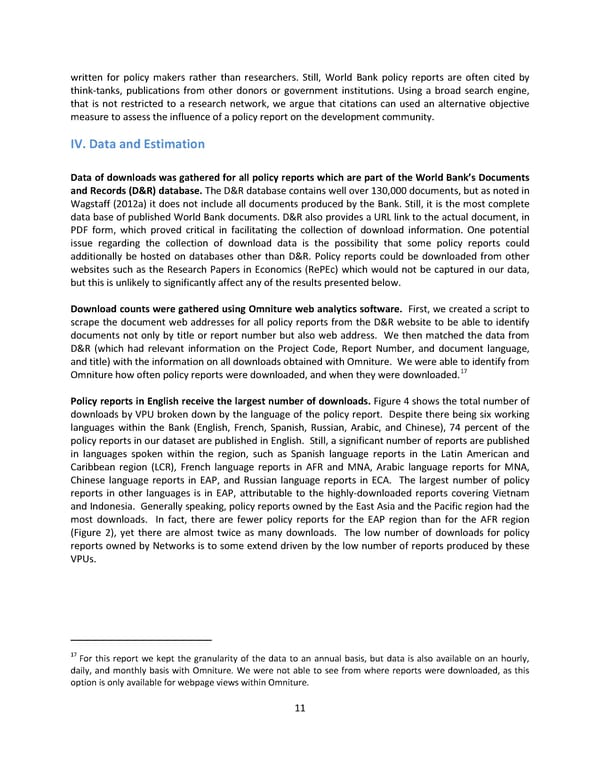written for policy makers rather than researchers. Still, World Bank policy reports are often cited by think-tanks, publications from other donors or government institutions. Using a broad search engine, that is not restricted to a research network, we argue that citations can used an alternative objective measure to assess the influence of a policy report on the development community. IV. Data and Estimation Data of downloads was gathered for all policy reports which are part of the World Bank’s Documents and Records (D&R) database. The D&R database contains well over 130,000 documents, but as noted in Wagstaff (2012a) it does not include all documents produced by the Bank. Still, it is the most complete data base of published World Bank documents. D&R also provides a URL link to the actual document, in PDF form, which proved critical in facilitating the collection of download information. One potential issue regarding the collection of download data is the possibility that some policy reports could additionally be hosted on databases other than D&R. Policy reports could be downloaded from other websites such as the Research Papers in Economics (RePEc) which would not be captured in our data, but this is unlikely to significantly affect any of the results presented below. Download counts were gathered using Omniture web analytics software. First, we created a script to scrape the document web addresses for all policy reports from the D&R website to be able to identify documents not only by title or report number but also web address. We then matched the data from D&R (which had relevant information on the Project Code, Report Number, and document language, and title) with the information on all downloads obtained with Omniture. We were able to identify from Omniture how often policy reports were downloaded, and when they were downloaded.17 Policy reports in English receive the largest number of downloads. Figure 4 shows the total number of downloads by VPU broken down by the language of the policy report. Despite there being six working languages within the Bank (English, French, Spanish, Russian, Arabic, and Chinese), 74 percent of the policy reports in our dataset are published in English. Still, a significant number of reports are published in languages spoken within the region, such as Spanish language reports in the Latin American and Caribbean region (LCR), French language reports in AFR and MNA, Arabic language reports for MNA, Chinese language reports in EAP, and Russian language reports in ECA. The largest number of policy reports in other languages is in EAP, attributable to the highly-downloaded reports covering Vietnam and Indonesia. Generally speaking, policy reports owned by the East Asia and the Pacific region had the most downloads. In fact, there are fewer policy reports for the EAP region than for the AFR region (Figure 2), yet there are almost twice as many downloads. The low number of downloads for policy reports owned by Networks is to some extend driven by the low number of reports produced by these VPUs. 17 For this report we kept the granularity of the data to an annual basis, but data is also available on an hourly, daily, and monthly basis with Omniture. We were not able to see from where reports were downloaded, as this option is only available for webpage views within Omniture. 11
 Which World Bank Reports Are Widely Read? Page 16 Page 18
Which World Bank Reports Are Widely Read? Page 16 Page 18